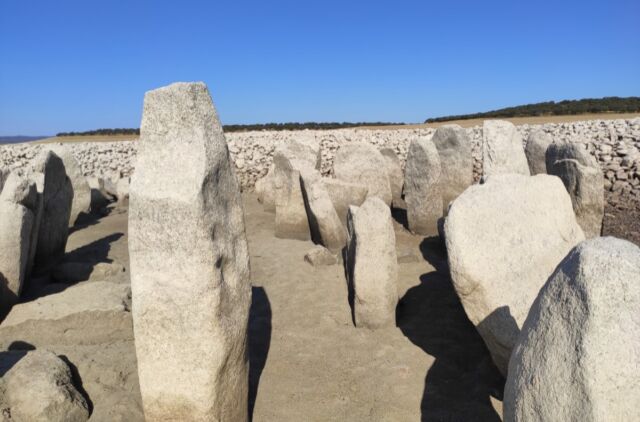

“Spanish Stonehenge” emerges from watery grave for second time in last 3 years
source link: https://arstechnica.com/science/2022/08/spanish-stonehenge-emerges-from-watery-grave-for-second-time-in-last-3-years/
Go to the source link to view the article. You can view the picture content, updated content and better typesetting reading experience. If the link is broken, please click the button below to view the snapshot at that time.
The "treasure of Guadalperal" —
“Spanish Stonehenge” emerges from watery grave for second time in last 3 years
The Dolmen of Guadalperal dates back to between 2000 and 3000 BCE.
Jennifer Ouellette - 8/24/2022, 10:36 PM

Last week we told you about the flurry of recent coverage resurfacing 2018 news stories about the re-emergence of so-called "hunger stones" due to extreme drought conditions in Europe. We also noted that Europe is once again in the midst of a historically severe drought. Now an ancient site known as the "Spanish Stonehenge"—submerged underwater by a reservoir for decades—has been fully exposed for the second time since 2019 due to low water levels in the reservoir.
The site is also known as the Dolmen of Guadalperal, a circular grouping of 150 large vertical granite stones (called orthostats) dating back to between 2000 and 3000 BCE. However, Roman artifacts recovered at the site—a coin, ceramic fragments, and a grinding stone—suggest it might have been used even earlier. A team led by German archaeologist Hugo Obermaier discovered the monument in 1926 near a town called Peraleda de la Mata.
Among the recovered artifacts were 11 axes, flint knives, ceramics, and a copper punch. A nearby settlement likely housed the people who built the monument, given the presence of houses, charcoal and ash stains, pottery, and stones to hone axes. Obermaier restored some of the granite stones to their rightful places and made reproductions of the engravings, which were published in 1960.
The vertical stones form an ovoid chamber (dolmen) connecting to a long (21 meters, or 69 feet) corridor. At the corridor entrance is a large standing stone, or "menhir," carved with what appears to be a snake. The chamber was covered with a mound of earth and gravel surrounded by another circular ring.
The exact purpose of the site remains a matter of debate, but it was most likely used as a solar temple, a trading post along the Tagus River, or a burial enclave. Per Atlas Obscura:
When it was intact... people would have entered through a dark, narrow hallway adorned with engravings and other decorations, probably carrying a torch. This would lead to an access portal into the more spacious main chamber, which had a diameter of around 16 feet, where the dead would be laid to rest. It’s also likely that the monument was oriented around the summer solstice, allowing, for just a few moments a year, the sun to shine on the community’s ancestors. Construction of such a large space, with such heavy materials, would have taken a great deal of both effort and ingenuity.
In 1963, Spanish dictator Francisco Franco ordered the construction of a dam to create the Valdecañas reservoir. The massive project meant that underdeveloped areas of Spain now had water and electricity, but the dolmen and the remains of the Roman city Augustobriga were buried under the water, along with an inhabited town. (The residents were relocated.)
AdvertisementResidents had seen the tips of the dolmen poking out of the reservoir waters before, but in 2019 two major heat waves brought a severe drought that swept across Europe, lowering the water level so drastically that the entire structure was fully visible for the first time since the dam was built. NASA even released satellite images that showed the "Spanish Stonehenge."
And now drought is once again plaguing Europe, and the Dolmen of Guadalperal is fully visible. Being submerged for all those decades hasn't been good for the porous granite stones, some of which show signs of erosion and cracking, while others have fallen over. Some have called for the Spanish government to move the stones to permanently dry land, while others worry that this could cause additional damage, especially if the process was rushed.
In a recent paper, archaeologist A.J. Villa González also decried the "massive influx of tourists to the site, despite the two-hour walk through muddy terrain to reach it." People not only strolled through private property, but also risked their health due to "the intense heat and the complexity of the terrain." The Spanish government declared the site as being of cultural interest and is developing a protection plan to preserve the monument for future generations.
DOI: Internet Archaeology, 2022. 10.11141/ia.60.4 (About DOIs).
Recommend
About Joyk
Aggregate valuable and interesting links.
Joyk means Joy of geeK
